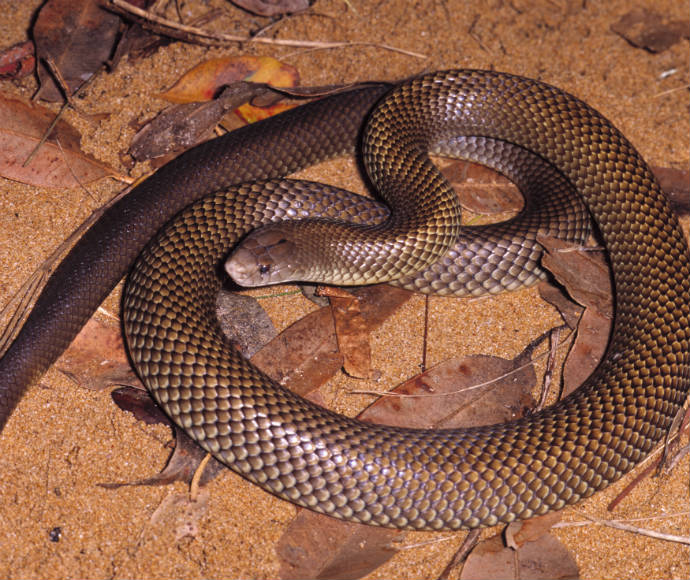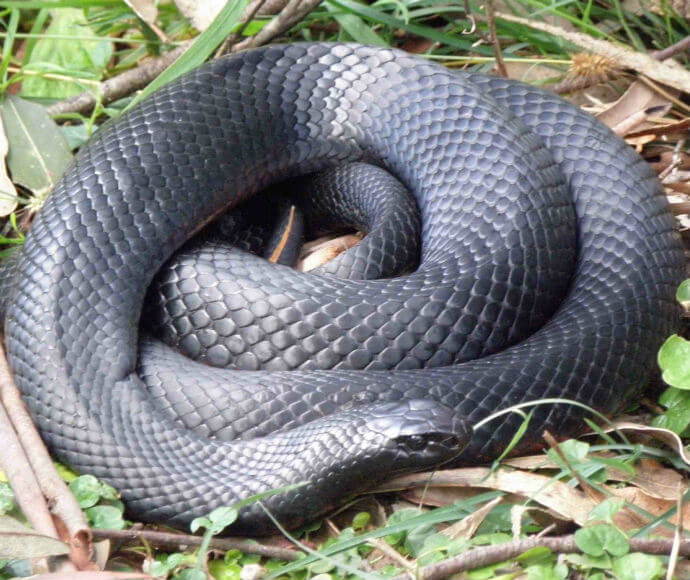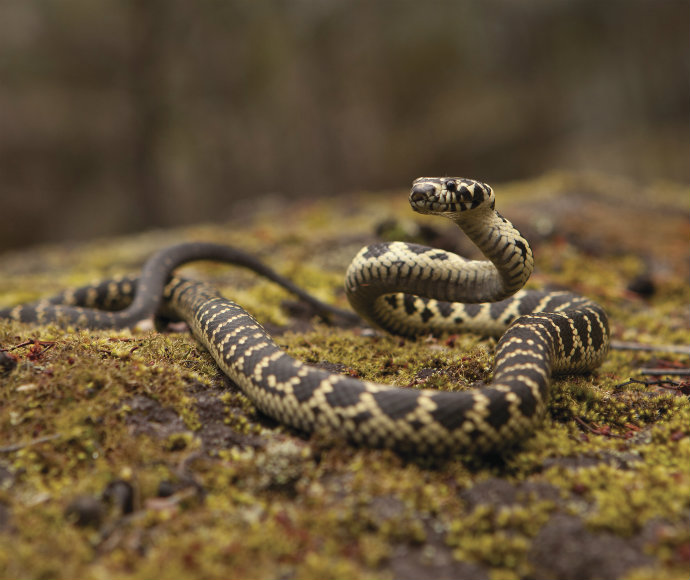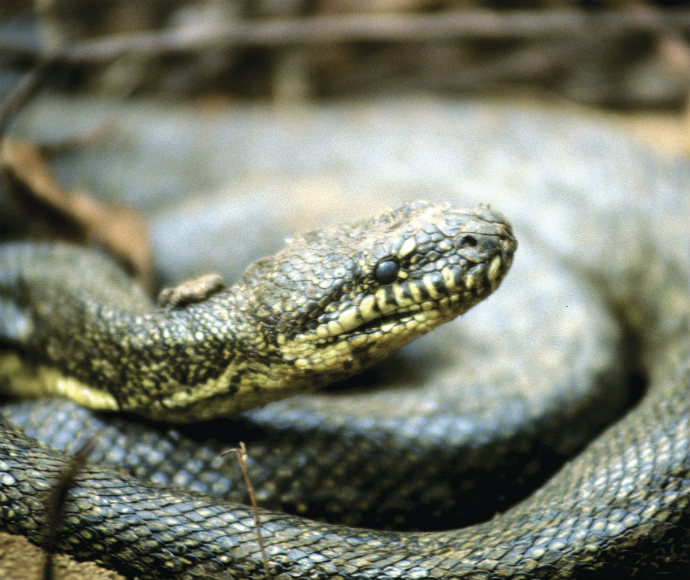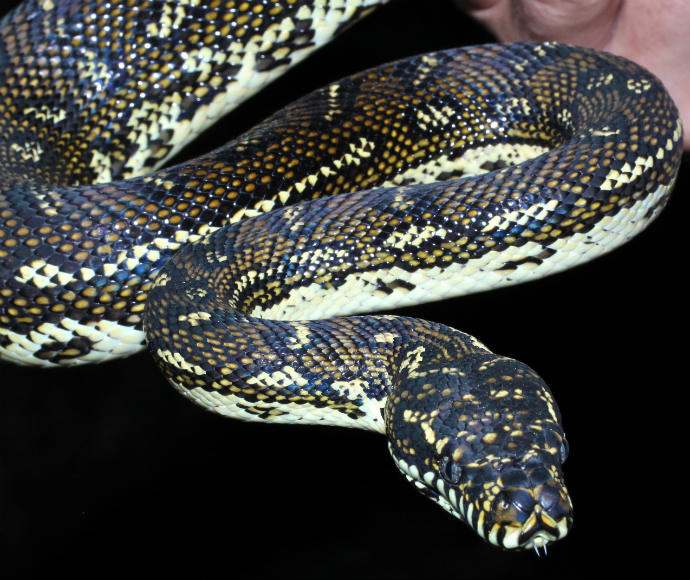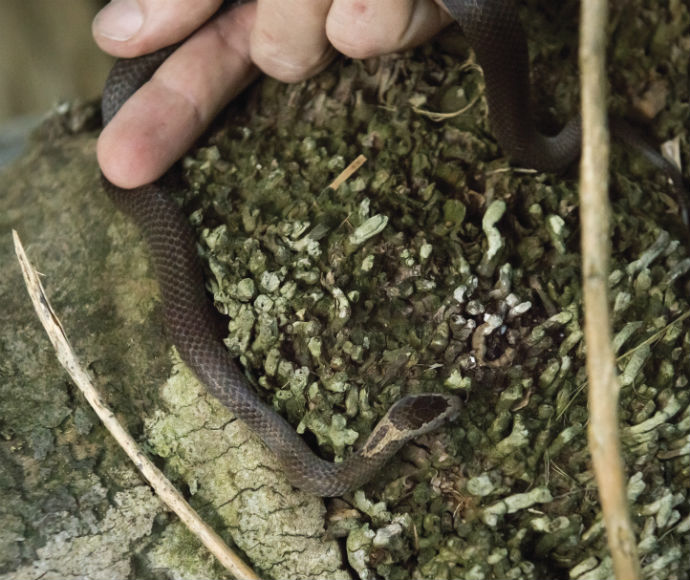Some 100 Australian snakes are venomous, although only 12 are likely to inflict a wound that could kill you. The most dangerous snakes belong to the front-fanged group, which in New South Wales includes the tiger snake, brown snake, death adder, mulga or king brown snake and a few species of sea snake.
Australia's other snakes are the solid-toothed non-venomous snakes (such as pythons, blind snakes and file snakes) and venomous rear-fanged snakes (such as the brown tree snake and mangrove snakes).
Living with snakes
Snakes are not naturally aggressive and always prefer to retreat. They will only attack humans if hurt or provoked and most bites occur when people try to kill or capture snakes. If you come across a snake in the bush, just calmly walk the other way.
If you find a snake in your home or garden and would like it removed, contact your nearest snake catcher on the reptile handler list.
Sea snakes in New South Wales
Eleven species of sea snake and one species of sea krait have been recorded in New South Wales waters. Most of the sea snakes recorded from New South Wales are seen very infrequently and are vagrant individuals that have strayed from their core tropical populations.
The exception is the yellow-bellied sea snake (Pelamis platurus), which is considered abundant and is probably a long-term resident in the oceanic waters off the NSW coast.
In the marine environment, sea snakes occupy a range of habitats, from muddy turbid estuarine waters to clear waters of coral reefs. Most species live in warm tropical or subtropical waters.
Read the Identification guide for sea snakes in New South Wales (PDF 196KB).
How snakes see, smell and hear
Snakes have no eyelids and cannot close their eyes. Their eyes are protected by a clear scale, which is part of their skin and functions like spectacles. Many snakes have excellent eyesight, particularly some of the daytime predators (such as whip snakes), and most have good eyesight, at least over short distances.
However, in most snakes the sense of smell is more vital. A snake's main organ of smell is its forked tongue, which it flicks in and out of its mouth. The tongue picks up scent particles from the air and any objects it touches and transfers them to two depressions in the roof of the mouth. These depressions are unique to reptiles and detect scents transferred to them from the tongue. A snake's nostrils are only used for breathing.
Snakes do not have outer ears. Instead, they hear with inner ears, which pick up vibrations from the ground through the head and belly scales. Some nocturnal snakes, such as pythons, also have heat sensory pits to help them locate the 'warm' birds and animals they prey on.
How they move
Not having legs, snakes use waves of muscle contractions along their bodies to move. Movement is helped by the belly scales, which catch on any uneven surface. If the ground is very smooth, snakes find it difficult to move in any direction at all.
Tree-living snakes, such as pythons, 'shuffle' along horizontal branches in muscular waves which pass along their bodies.
Most snakes are good swimmers, and sea snakes have paddle-shaped tails which give them added propulsion in the water.
Sloughing (shedding) their skin
A snake sheds its skin between one and 4 times a year. It does this by rubbing the front of its head on a rough surface until the skin splits. The snake then slowly sloughs out of the skin, turning it inside out as it does so. In all snakes, the new skin (with the same colours and patterns as the old) is underneath and, when shed, the old skin is almost transparent. When a snake is about to slough, the scale forming the spectacle over its eye will become 'milky', affecting its vision.
How they control their body temperature
Snakes are reptiles, which means they are ectothermic: they get their body heat from external sources.
Endothermic animals, such as mammals and birds, regulate their body temperature internally. A snake's body temperature – and so its level of activity – is controlled by the temperature of the air and the ground. It will try to maximise body heat by basking in the sun or lying on or near warm surfaces such as night-time roads or even, on occasion, household water heaters.
In cold areas of the state, snakes hibernate during winter. However, in the more temperate climate along the coast they shelter in rock crevices and logs during cold weather and come out on warm days to soak up the heat of the sun. During cold weather, snakes are less active and therefore hunt less. In the winter their metabolisms slow down, and they use up body fat which has been stored up during the warmer months of the year.
How they feed
Catching and feeding is a very specialised activity. Snakes have no claws to grab, tear or hold their food and can’t chew because their teeth and hinged jaws aren’t designed for that purpose.
Most venomous snakes grab their prey by striking suddenly and biting while they inject venom into the victim. Some species will often strike 3 or 4 times. The toxins produced by the venomous snakes act to paralyse the victim so that it dies or is unable to move before the snake tries to eat it. These toxins also assist the snake's digestive processes, beginning by breaking down the victim's blood and other tissues.
Pythons have no venom and use their strong bodies to immobilise their victims. Having first grabbed the prey with its mouth, a python wraps its body coils tightly around the victim. As the coils are progressively tightened, the prey is suffocated.
Other snakes grab their prey in their mouth and start swallowing immediately so the animal is eaten alive. The teeth in these snakes are arranged to resist escape of an animal once grabbed in the mouth. Sometimes both venom and constriction are used to kill and hold the prey.
A snake can dislocate its upper and lower jaws and separate the two sections of its lower jaw. This allows it to move each jaw independently and to spread open its head and throat to swallow prey much larger than the usual diameter of its mouth. Digestion takes place in the stomach, with the aid of strong digestive juices. Unlike endothermic animals, a snake's food digestion rate is influenced by external temperatures.
How they breed
Some snakes reproduce and give birth to live offspring, while others lay eggs. Most egg-laying snakes don’t look after their eggs before hatching. Some deposit them in warm, rotting vegetation to incubate the eggs for 10 to 14 weeks.
Pythons 'incubate' and protect their eggs by coiling their bodies around the eggs, almost continuously, until they hatch. They can control temperature to a certain degree by shivering.
Young snakes fend for themselves from birth. Depending on the species, each parent snake may produce between 10 and 100 young in one breeding season. Many young are lost to predators such as birds, lizards and other snakes.
Populations in decline
Snakes play an important role in many different types of ecosystems. However, their numbers are generally declining. Probable reasons for the decline include:
- removal of snake habitat through clearing land for agriculture or urban development
- more frequent bushfires
- people taking bush rock (an important source of shelter for snakes) from the bush for gardens
- introduced predators such as foxes, dogs and cats
- snakes being run over on roads
- the indiscriminate killing of snakes by people who fear or dislike them. Many harmless snakes, and even legless lizards, are killed unnecessarily in this way.
A number of snake species have been listed as threatened in New South Wales.
Protection of native animals
All native birds, reptiles, amphibians and mammals, but not including dingoes, are protected in New South Wales by the Biodiversity Conservation Act 2016.
